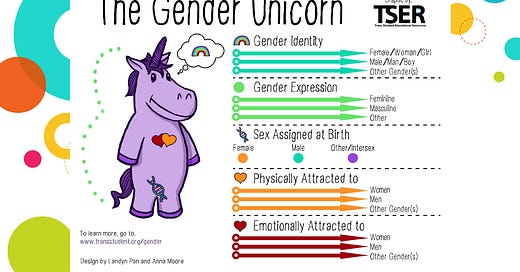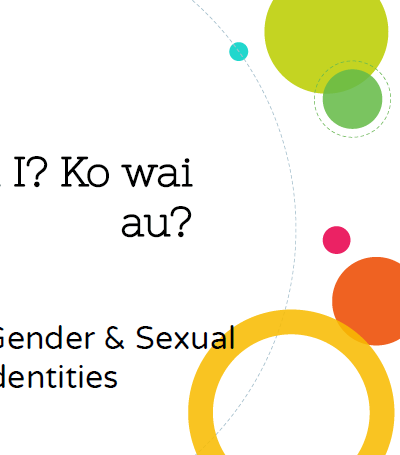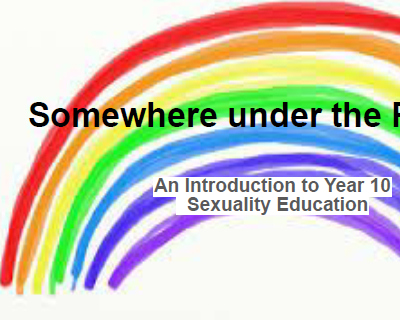What Hutt Valley High School is teaching kids about sex
This New Zealand school hosts a club for sharing advice on breast binding and cross-sex hormones

This article was first published in Plain Sight and has also been republished by Resist Gender Education.
Hutt Valley High School didn’t want parents to see the classroom materials that I’m about to show you. And it’s little wonder.
Many of the school’s parents are probably under the impression that the school is merely teaching their children to be kind to gay and trans people, which would be admirable if it were true. The content of these lessons dispels that myth.
These classroom materials were provided to me by concerned parents at Hutt Valley High, a large, co-ed high school located near Wellington (New Zealand’s capital city). My contact told me that the school was initially very reluctant to share these materials with parents, and did so only once the possibility of an Official Information Act request was mentioned.
Past media reports have revealed toxic mould and brutal sexual assaults at Hutt Valley High. Unfortunately, these classroom materials are likely to once again undermine parents’ trust in the school.
Hutt Valley High’s lessons are based in gender identity theory, an unscientific belief system that seeks to redefine boys and girls. Despite the fact that New Zealand parents are overwhelmingly opposed to gender identity theory, our Ministry of Education has been attempting to introduce these types of lessons across New Zealand. At Hutt Valley High, they have succeeded.
The underlying messages sent by Hutt Valley High’s lessons are that:
Your biological sex was arbitrarily assigned to you, and can be changed.
Whether you are ‘really’ male or female depends on your feelings about gender roles, and is independent of your biology.
Girls who don’t feel comfortable with the stereotypical female gender role should consider medical gender transition (as should boys who don’t feel comfortable with male stereotypes).
Disagreeing with any of these beliefs is unacceptable (i.e. ‘transphobic’).
These messages are false and potentially harmful. Hutt Valley High’s lessons risk nudging vulnerable adolescents into a descent into lifelong medical dependency.
The broader context
Medical gender transition involves the use of puberty blockers, cross-sex hormones, and/or surgeries to mimic the superficial appearance of the opposite sex. The number of young New Zealanders undergoing medical transition has increased dramatically in recent years.
Youth gender transition is controversial and unproven. Sceptical clinicians and researchers have described it as “dangerous medicine”, comparing it to the frontal lobotomies that were popular in an earlier era of psychiatry. Britain’s National Health Service recently restricted puberty blockers to research settings, citing the “significant uncertainties surrounding the use of hormone treatments”. In New Zealand, MedSafe (our medicines safety regulator) has warned the Ministry of Health that by publicising the off-label use of these drugs for gender-questioning children, it could be breaking the law.
One likely cause of the recent spike in gender-related distress is a shift in beliefs about sex and gender. These new beliefs encourage teenagers to interpret feelings of general unhappiness, discomfort with their developing bodies, or not fitting into stereotypical gender roles as signs of ‘being trans’. We can see this reflected in research into young people who detransition (e.g. stop taking opposite sex hormones). Here’s how one research participant explains the impact of gender identity theory on her decision to medically transition:
People said well, everyone has a gender identity. So, if… you're happy being a woman and you're happy being treated like a woman, then you have a female or a woman's gender identity or whatever. And I felt like Oh well, I'm not so I must be a man gender identity… So I felt like OK that's the path I have to go down… it was definitely being told… if you don't identify as a woman, then you're transgender.
She says that she eventually realised that the concept of gender identity is “just kind of nonsense”, and has now detransitioned.
Another detransitioner, Laura Becker, explains in a personal video essay that she transitioned after becoming immersed in gender identity theory on social media:
Tumblr exacerbated my vulnerabilities through an entire internet’s worth of irrational ideology like queer theory, gender identity, and woke, radical leftist social justice tactics which socially encouraged the breakdown of self-concept into an identity crisis.
Laura’s journey to detransition began when she encountered criticisms of gender identity theory. She grew to understand that she had transitioned in a misguided attempt to deal with trauma, not because she was ‘born in the wrong body’. She now describes gender identity theory as “spiritual and ideological nonsense”.
Similarly, in an essay in The American Mind, detransitioner Sierra Weir explains that she started experiencing gender distress after becoming immersed in gender identity theory at university. Her distress evaporated when she stopped believing in the idea of a gendered soul. She is relieved to have narrowly avoided irreversible surgical treatments, titling her essay “How gender atheism saved my body”.
And similarly again, well-known detransitioner Helena Kerschner writes bluntly that “It was this weird belief system I found on the internet that made me want to be trans”, and that learning to doubt that belief system was a key part of her recovery.
“It was this weird belief system I found on the internet that made me want to be trans” — Helena Kerschner, detransitioner
These four young women are far from unique. Gender identity theory is often an integral theme in stories of transition and detransition. In fact, a recent study of 100 detransitioners found that the most common reason given for detransitioning was that “My personal definition of female or male changed and I became more comfortable identifying as my natal sex”.
Of course, not every young person exposed to gender identity theory will end up transitioning - only a vulnerable few. Gender identity theory is just one part of a more complex picture. But redefining ‘female’ and ‘male’ as subjective gender identities may increase the risk of gender-related distress and subsequent transition. As we will see, Hutt Valley High’s lessons redefine female and male in exactly this way.
Concerns that gender identity instruction will influence teenagers towards transition are sometimes dismissed by claiming that gender identity is fixed and innate (and thus that the decision to transition is immune to the social influences that impact most human behaviour). However, there is no convincing evidence for the idea of a fixed or innate ‘brain sex’. New Zealand’s Department of Internal Affairs has acknowledged that “gender [identity] can be fluid” and “may change at different stages of life”, and even our Ministry of Education has admitted that gender identity “is not fixed or immutable”. Claims that gender identity is similar to left-handedness or same-sex attraction (both of which do appear to be stable and biologically-based) are thus misleading.
Instead, research suggests that when young people experience gender distress, it often resolves over time if social and/or medical transition is avoided. Britain’s National Health Service has warned that among “children and young people”, gender distress “may be a transient phase”. Recent studies show that up to 30% of young people who take cross-sex hormones detransition within just a few years, suggesting that trans identification is often temporary, even among young adults.
Both clinicians and parents have also observed numerous cases where gender distress appears to arise ‘out of the blue’, often in the wake of exposure to trans influencers (e.g. through schools, peers, the media, exploitative TikTok and YouTube videos, and manipulative online communities). As a 2021 research review of youth gender transition, published on the widely respected medical website Medscape Psychiatry, put it:
There is legitimate concern that... comorbid mental health conditions, as well as the influence of social groups and online immersion into transgender topics, may be playing a role in the rapidly growing rate of transgender identification among these particularly vulnerable youth.
Schools that embrace gender identity theory may put their students at particular risk. For example, in 2016, Pittsburgh Public Schools started training all its staff in concepts of gender identity. This initiative grew into a comprehensive “plan of building acceptance and understanding around concepts of gender identity and expression” among students, staff, and school families. Astonishingly, by late 2018 nearly one in ten students in this school district identified as transgender, genderqueer, nonbinary, or another unspecified gender identity; marking them as potential candidates for life-changing hormonal and surgical interventions.
In this context, it’s essential for all schools to take a careful, science-based approach to their Relationships and Sexuality Education lessons (as recently recommended in guidance from the UK Attorney General). Unfortunately, Hutt Valley High’s lessons follow a very different path.
Inside the lessons
It should be first noted that the Hutt Valley High lessons are loosely organised and sometimes self-contradictory. Often I agreed with what the slides and videos had to say, for example in the places where they encourage acceptance of gay sexuality and freedom from the restrictions of sex stereotypes. However, several aspects of the lessons caused me grave concern.
The first thing that stood out to me was actually nothing to do with gender. It was a strange claim about animals and sex.
The slide shown above claims that humans, and possibly dolphins, are the only animals that have sex for pleasure. Other animals, it claims, have sex only to “produce more of their species”. This is incorrect.
In reality, the animal most famous for indulging in non-procreative sex is the bonobo (an ape species closely related to humans). A quick Google search finds plenty more examples. This 2014 BBC article, for example, lists white-faced capuchin monkeys, lions, Japanese macaques, spotted hyenas, and several other species.
This glaring mistake suggests that Hutt Valley High’s lessons have not been properly fact checked. Unfortunately, these lessons contain other false information which is far more fundamental and consequential. One example is this slide, which misinforms students about the nature of sex itself:
This slide states that when referring to someone’s sex, it’s essential to use the term “sex assigned at birth”. The reason given for this is that the word “sex” by itself is supposedly a “vague” term loaded with “transphobia”. To provide further explanation and ‘evidence’ for this extraordinary claim, the slide links to an article in a queer radical magazine, written by a self-described “entertainment journalist and cultural critic”. This article claims, based on distorted logic and a very poor understanding of biology, that:
There’s nothing intrinsically male about XY chromosomes, testosterone, body hair, muscle mass or penises… Sex, like gender, is indeed socially constructed and can be changed.
It’s truly alarming that a New Zealand school would base its lessons in such a bizarre and thoroughly confused worldview. In reality, of course, sex is an objective biological fact which occurs in most animal species. Biological sex existed long before humans were around to “socially construct” anything. In biology, sex has a precise technical definition that is neither “vague” nor laden with prejudice.
The article’s claim that sex can be changed is also factually incorrect. Male and female are two biologically distinct developmental pathways, one of which evolved to lead to potential fatherhood, and the other to potential motherhood. Because the human body is a complex system, a doctor cannot transform you from male to female, any more than a vet could turn a dog into a cat.
Requiring compliance
Students with a modicum of common sense will naturally have difficulty believing the claim that there’s nothing inherently male about penises. However, the Hutt Valley High lessons warn such students that their doubts are symptoms of “transphobia” (see the slide above). The implied threat is that students must keep their doubts to themselves, lest they suffer the harsh treatment meted out by trans activists to those they accuse of transphobia.
This is what makes these lessons so potentially damaging. If these high school students were being introduced to gender identity theory in a neutral way that encouraged critical thinking, that would be fine. Instead, they are being told, falsely, that these ideas are scientifically established and that they must accept them or risk being accused of bigotry. According to my contact, this has created a climate of fear within the school, where few students are willing to openly state their belief in biological reality.
Even worse, the lessons require students to not just accept gender identity theory, but to put these ideas into practice. They mandate that students must actively participate in socially transitioning their peers.
Social transition is a powerful psychosocial intervention that entails treating someone as if they were the opposite sex. While social transition often includes cosmetic changes like new clothes and a new hairstyle, its core component is referring to the person by opposite-sex or gender-neutral pronouns.
Worrying evidence suggests that early social transition may ‘lock in’ a trans identity, prolonging gender distress and putting young people on the pathway to eventual medical transition. While activists claim that social transition is essential to the mental health of gender questioning youth, three high-quality studies have found that it has few if any real benefits.
For these and other reasons, the UK Attorney General recently provided cautionary guidance to schools, stating that:
Schools have a duty of care in relation to the health, safety and welfare of their children and they risk breaching this duty when they encourage and facilitate a child’s social transition as a blanket policy; or take the decision to do so without medical advice.... This is particularly so when the child is harmed as a consequence, especially if social transition were to lead subsequently to binding, or medical or surgical procedures, and even more so if done without the knowledge or consent of the child’s parents...
Further, no child should be made to fear punishment or disadvantage for questioning what they are being taught, or refusing to adopt a preferred pronoun for a gender questioning child, or complaining about a gender questioning child using their toilets or changing rooms... The right to freedom of belief, thought, conscience and speech must be protected.
Hutt Valley High’s lessons, however, demand that students (and presumably teachers) brush any concerns about the detrimental effects of social transition to one side. A video included in the lessons (‘Gender Identity - The REAL Sex Talk’) instructs students:
If you get confused about what pronouns to use, again, just ask. Trans people experience some of the worst abuse from society, and this is motivated by transphobia. Transphobia can be lots of different things, but two examples include intentionally using the wrong pronouns or doing what we call deadnaming. Deadnaming means calling someone the name that they had before they transitioned. Don’t do it... So if you identify as transgender and you’re experiencing transphobia, you can reach out to a trusted adult or get in touch with Rainbow Youth, or in extreme cases, the police.
In other words, the lessons require students to ‘affirm’ their young peers down a pathway towards lifelong medicalisation, or face being reported to the authorities for “transphobia”. This puts students in an unconscionable position, requiring them to say things they don’t believe and may well know are harmful.
In short, these lessons intrude on students’ freedom of speech, belief, and conscience. They also seem destined to create a school environment where gender questioning students are influenced in only one direction: towards the syringe and the scalpel.
Medicalising gender nonconformity
How can students know whether they are suitable candidates for social and/or medical gender transition? The Hutt Valley High lessons explain that this decision should be made on the basis of a vaguely defined “internal sense” called “gender identity”. Here’s how the lessons explain the concept of gender identity:
This slide says that being female, a woman, or a girl; or conversely male, a man, or a boy; is not based on your biology, but that these words instead refer to “just six common gender identities”. It also claims, oddly, that being “female” and a “woman” are “not necessarily linked to each other”.
The slide then makes the dubious claim that everyone has a gender identity that determines whether they’re trans, stating this as if it was an uncontroversial fact. It defines gender identity as an “internal sense of being male, female, neither of these, both, or another gender(s)”. It’s not self-evident what this hypothetical “internal sense” of being male or female is supposed to feel like, and the slide does not explain this.
However, the included REAL Sex Talk video does explain how to recognise that your gender identity is misaligned with your body. Here’s how a young woman featured in this video says that she decided she was trans:
So I think I was about 14 when I first started playing around with my gender. Obviously there’s been moments in my life before then that have been, kind of, not strictly male or female. And I felt quite comfortable flipping between the two. But I think it was when I hit school and worked out that girls do this and boys do that, and it started not working for me. So, I think God bless the internet is all I’m going to say because that really gave me the resources and the curiosity to go and look at what’s out there, and that gave me a lot of strength to pursue finding out who I really am.
Did you catch that? According to this video, if you hit adolescence and you don’t feel comfortable adhering to rigid gender roles (i.e. “girls do this and boys do that”), that means you’re trans. By this young woman’s own account, she was perfectly comfortable with her female body until she reached puberty, experienced discomfort with societal gender expectations, and started immersing herself in online trans spaces. This online immersion was the trigger for adopting a trans identity and deciding to take synthetic testosterone. And Hutt Valley High is presenting this young woman as a role model for its students to follow.
According to this video, if you hit adolescence and you don’t feel comfortable adhering to rigid gender roles, that means you’re trans.
The REAL Sex Talk video makes it clear that your discomfort with traditional gender roles doesn’t need to be extreme or distressing for you to qualify as trans. Instead, the video implies that considering yourself to be a man or a woman is extreme. Here’s how the video explains this:
Before a baby is born, half of what anyone talks about is whether it's going to be a boy or a girl. But just like sexual orientation, gender is a spectrum. It’s not as simple as pink or blue. A spectrum is like a line. So, woman, non-binary, man. And they’re all somewhere along the same line.
Notice that the video thoroughly confuses gender (identity) and sex. Once again, being a man or a woman is described as a feeling, rather than as a biological fact. Also notice that “woman” and “man” make up only the 1% most extreme points of this graphic. The visual implication is that most students are probably non-binary, at least to some degree.
It’s no accident that the REAL Sex Talk video presents discomfort with traditional gender roles as a symptom of a misaligned gender identity, and thus of ‘being trans’. This message is consistent with popular kids’ books about gender identity, which more-or-less explicitly define gender identity as an affinity with sex stereotypes. So do official sources like the World Health Organisation. In fact, it’s unclear how gender identity could be meaningfully defined without reference to sex stereotypes.
Tragic consequences
The Hutt Valley High lessons fail to highlight the potentially serious medical consequences of starting down the trans pathway. Instead, the lessons present ‘being trans’ as, literally, rainbows and unicorns (i.e. one of the slide packs is titled “Somewhere under the rainbow” and features a rainbow on every slide; while the other prominently features a “gender unicorn”).
From this rainbows-and-unicorns perspective, hormones and surgery are advertised as a joyful path to self-actualisation, rather than as risky medical interventions. The slide about gender identity (shown earlier) states that:
Many transgender people seek to make their gender expression (how they look) match their gender identity (who they are), rather than their sex assigned at birth.
Similarly, the REAL Sex Talk video states cheerfully:
Someone who is trans may take hormones or have surgery so that their body matches their identity. But all of these steps are optional, because nothing is compulsory when you identify as trans.
The fact that this video at least presents medical transition as optional might at first seem comforting. However, students who are prompted by the lessons to adopt a trans identity will enter a social world where breast binding and medical transition are constantly promoted as a cure for unhappiness and distress. (Girls who bind their breasts can lose consciousness during exercise or suffer long-term medical harm.)
For example, the flyer below advertises a ‘meet up’ where Hutt Valley High students can seek advice from other students on binding their breasts and starting on cross-sex hormones. The school has confirmed by email that the teacher who supervises this group is not medically qualified (I’ve redacted her name from the flyer).

The notion that medical interventions are “medically necessary” for “many trans and non-binary people” is promoted by numerous youth outreach groups in New Zealand, as well as by prominent media outlets here and internationally. For example, in 2019 the New York Times ran an irresponsible article titled ‘It’s Binding or Suicide’: Transgender and Non-Binary Readers Share Their Experiences With Chest Binders. Similarly, other media outlets have claimed that cross-sex hormones and gender surgeries are “life-saving care”. In reality, of course, there is no convincing evidence that binding or medical transition improve youth mental health.
Let’s put all this together. Hutt Valley High is teaching its students that their sex was arbitrarily assigned to them, and they can change it if they want to. It’s teaching them (perhaps inadvertently) that if they feel uncomfortable with sex stereotypes, then they should want to medically transition. It’s letting them believe that if they do transition, everything will be rainbows and unicorns. It’s requiring their teachers and their peers to reinforce (‘affirm’) any steps they take towards transition. And prominent media outlets are falsely telling them that if they don’t transition, they’ll probably end up dying by suicide. Is it any wonder that rates of youth gender transition have soared?
It seems to me that at heart, the whole point of Hutt Valley High’s lessons is to convince students to consider gender transition. Activist teachers would argue that the permanent medicalisation of teenagers is a good thing, reflecting greater acceptance of diversity and leading to greater happiness. While their faith in the benefits of gender medicine is doubtless sincere, the evidence suggests that they are sadly, tragically, brutally wrong.
And it is not Hutt Valley High’s teachers that will forever live with the consequences: the surgical complications, the chronic pain conditions, the heightened cardiovascular risks, the infertility, the psychological distress, the breakdown of family relationships, the regret. It’s the vulnerable adolescents in their care, and their families.
If you find Hutt Valley High’s lessons concerning, then it’s time to take an interest in the Relationships and Sexuality Education lessons in your own school. Hutt Valley High’s lessons are not unique; for example the REAL Sex Talk video quoted above has been viewed over eighteen thousand times, suggesting that it has reached a broad audience. Parents are starting to notice the spread of gender identity instruction in our schools, and its destructive effects. It’s up to you to protect your child.
New Zealand parents can find information on how to ask schools to exempt their children from lessons that encourage trans identification here.
For advice on how to approach schools with your concerns, you can contact Resist Gender Education.
You can read the Hutt Valley High School lessons in their entirety below.










